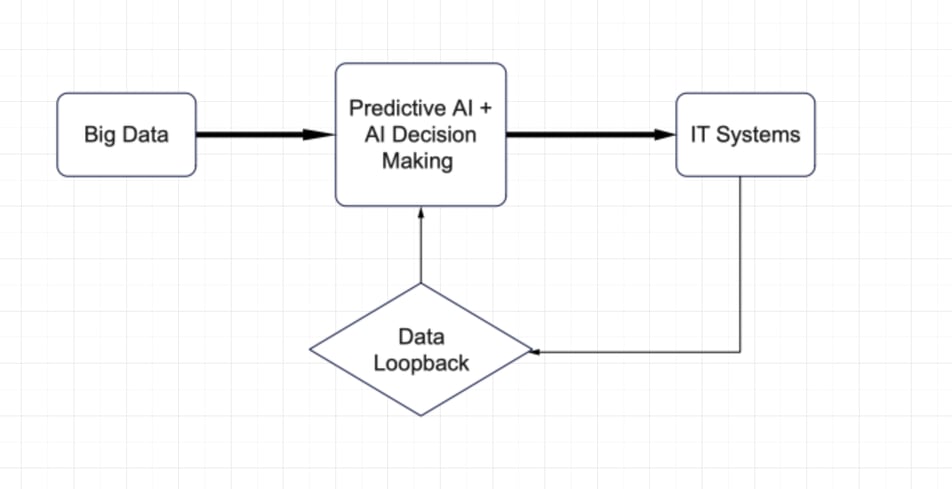How AI Can Revolutionize Resource Allocation in 5G
Explore how cutting-edge AI algorithms are transforming the telecom landscape, empowering product owners to revolutionize 5G network efficiency and deliver unparalleled connectivity. Uncover the strategic insights and benefits behind AI-driven resource allocation, unlocking a new era of seamless and optimized telecommunications experiences.
In the dimly lit executive suite of SkyCom Telecommunications (fictitious), John Turner, a seasoned telecom executive with a penchant for precision, found himself teetering on the precipice of professional disaster.
The amber glow of his desk lamp cast long shadows on the mahogany walls, amplifying the tension that hung in the air.
As he leaned back in his leather chair, engrossed in a high-stakes call with a key client, the haunting click echoed through the room – a familiar, dreaded sound that signaled the abrupt end of connectivity.
The ambient hum of the city below penetrated the thick glass windows.
John frantically tapped the touchscreen of his smartphone, desperately attempting to resuscitate the call.
An elusive client now lost in the digital ether.
In the script of his professional life, a world where every call carried the weight of destiny, this unexpected plot twist threatened to rewrite entire chapters.
As the digital seconds ticked away, the consequences of unreliable connectivity materialized like ghostly apparitions...
The underutilization of 5G
In the rapidly evolving field of telecommunications, the immense promise of 5G technology stands as a beacon of unparalleled connectivity. However, despite its potential, 5G networks often grapple with underutilization, leaving substantial bandwidth untapped.
Amidst these challenges, Artificial Intelligence (AI) emerges as a transformative force, offering strategic avenues to harness and optimize the latent power within 5G networks.
As mentioned in this article, the global AI telecommunication market was valued at USD 1.784 billion in 2022 and is projected to achieve a revenue CAGR of 38% throughout the forecast period, as indicated by the latest report from Reports and Data.
The current buzz around AI can make it confusing to distinguish between terms like AI, machine learning, and data science.
AI is the overarching concept of creating intelligent machines, Machine Learning (ML) is a subset of AI focused on learning from data, and Data Science involves extracting valuable insights from data using various methods, including machine learning. AI and machine learning are interconnected, and machine learning is one of the techniques used in the broader field of data science.
By leveraging AI capabilities, telecom providers can address underutilization issues, ensuring that the full potential of 5G is realized through intelligent resource allocation and network optimization.
Here are a few ways AI can contribute to maximizing the available 5G bandwidth:
Dynamic Resource Allocation:
AI algorithms can continuously monitor network conditions and user demands in real-time. By analyzing this data, AI can dynamically allocate resources, optimizing the distribution of bandwidth based on the current needs of connected devices. This ensures that resources are efficiently distributed, reducing latency and improving overall network performance.
Predictive Analytics for Network Optimization:
AI-driven predictive analytics can forecast network traffic patterns and user behavior. By understanding when and where network congestion is likely to occur, operators can proactively optimize network parameters and allocate resources accordingly. This predictive approach enhances network efficiency and minimizes the chances of congestion.
Smart Traffic Steering:
AI can be employed to implement smart traffic steering mechanisms. By analyzing data on the type of content being requested, the AI can intelligently direct specific types of traffic to the most appropriate network nodes. For example, latency-sensitive applications can be directed to low-latency edge servers, optimizing the user experience.
Quality of Service (QoS) Enhancement:
AI algorithms can monitor network performance metrics and user experience. When deviations from expected QoS levels are detected, AI can trigger adjustments in real-time to maintain or improve service quality. This ensures that critical applications receive the necessary bandwidth and low latency, even during periods of high demand.
Network Slicing for Customized Services:
AI can play a crucial role in implementing network slicing, a 5G feature that allows the creation of virtualized, independent networks tailored for specific applications. AI algorithms can dynamically allocate resources to different network slices based on the unique requirements of each application, providing customized services and efficient bandwidth utilization.
Energy-Efficient Network Management:
AI can contribute to optimizing the energy efficiency of 5G networks. By analyzing data on network usage patterns and equipment performance, AI algorithms can dynamically adjust the power consumption of network components, ensuring that energy is used efficiently while maintaining service quality.
The Architecture of AI systems
How would such AI systems look like?
The picture below describes the architecture of one such system.
An AI system, characterized by its self-learning capabilities, refers to a computational technology that can autonomously improve its performance over time without explicit programming. This ability is often associated with machine learning, a subset of AI that enables systems to analyze data, recognize patterns, and make predictions or decisions without being explicitly programmed for each task.
AI systems are computer-based technology that possess the capability to perform tasks that typically require human intelligence. This includes tasks such as learning, reasoning, problem-solving, perception, language understanding, and decision-making.
It is the self-learning capabilities of AI that makes it most useful.
Self-learning AI Systems
In the context of cellular technologies, below are examples of AI algorithms and processes that can be employed for effective resource allocation and management in a 5G environment:
Reinforcement Learning (RL) for Dynamic Resource Allocation:
In a dynamic environment like a 5G network, reinforcement learning can be used.
Reinforcement learning is a type of machine learning where an agent learns to make decisions by interacting with its environment. It involves the agent taking actions in an environment to achieve a goal and receiving feedback in the form of rewards or penalties. The goal of the agent is to learn a strategy that maximizes the cumulative reward over time.Now, imagine teaching a robot to fetch your morning coffee using reinforcement learning. At first, the robot might stumble around, knocking into things, and occasionally bringing you a shoe instead of a coffee mug. However, every time it successfully hands you the right cup, you give it a treat (positive reinforcement). Over time, the robot learns to navigate your home without causing chaos and consistently delivers your much-needed caffeine fix. It's like training a caffeine-powered, slightly clumsy but endearing robotic barista!
RL agents learn from interactions with the network, receiving feedback based on the effectiveness of their resource allocation decisions. Over time, the RL algorithm adapts its strategy to maximize network efficiency, considering factors such as bandwidth usage, latency, and user satisfaction.
Machine Learning (ML) for Predictive Analytics:
Machine learning algorithms, particularly predictive analytics models, can analyze historical data to forecast network traffic patterns. By identifying peak usage times and locations, these models can help operators proactively allocate resources where they are expected to be most needed, minimizing congestion and optimizing performance.
But what is Machine learning?
Machine learning is like having a really smart friend who learns from experience without being explicitly told what to do. Imagine you have a friend who's terrible at guessing your favorite pizza toppings. At first, they randomly suggest weird combinations like pineapple and anchovies. However, every time they get close to your actual preference, you give them a thumbs up (positive feedback). Over a series of pizza nights, your friend starts to figure out the perfect topping combination without you having to spell it out. It's like magic, but with algorithms and cheese! That's machine learning – making predictions and getting better at it through experience.
Machine learning is specially good in self learning and extracting insights which can be acted on by other components in the tech stack.
Convolutional Neural Networks (CNNs) for Traffic Classification:
CNNs can be employed to analyze network traffic and classify it based on content type or application. This information is valuable for smart traffic steering, where the AI can direct specific types of traffic to network nodes optimized for handling that content, improving overall efficiency.
A Convolutional Neural Network (CNN) is a specialized type of deep learning algorithm designed for image recognition and processing. Inspired by the visual processing in the human brain, a CNN consists of layers that perform convolutions, enabling it to learn hierarchical representations of features within images. These networks are particularly effective at recognizing patterns, objects, and structures in visual data
Convolutional Neural Networks (CNNs) are like expert detectives with a quirky sense of humor, especially good at recognizing patterns in images. Imagine you have a group of detectives assigned to identify your friend Bob in a crowded party photo. Each detective focuses on specific features like Bob's hat, glasses, or his unmistakable dance moves. They pass around their findings, collaborate, and eventually, the chief detective compiles all the clues to confidently shout, "There's Bob!" It's like having a team of image-savvy detectives with a knack for spotting familiar faces in a sea of pixels – that's the convolutional magic of CNNs!
QoS Monitoring and Decision-Making:
AI algorithms, such as decision trees or rule-based systems, can continuously monitor Quality of Service (QoS) metrics. If deviations from acceptable levels are detected, the AI system can trigger actions to adjust network parameters, prioritize certain types of traffic, or allocate additional resources to maintain QoS.
Network Slicing with Intelligent Orchestration:
Network slicing involves creating virtualized, independent networks for different services. AI-driven orchestration platforms can analyze service requirements and user demands to dynamically allocate resources to each network slice. This ensures that each slice receives the appropriate bandwidth, latency, and other resources tailored to its specific needs.
Multi-Armed Bandit Algorithms for Adaptive Learning:
Multi-Armed Bandit algorithms are well-suited for scenarios where the AI needs to balance exploration (trying different resource allocation strategies) and exploitation (sticking to the most effective strategy). In the context of 5G, these algorithms can be used to iteratively adjust resource allocations based on real-time feedback and performance metrics.
Natural Language Processing (NLP) for User Experience Analysis:
NLP algorithms can analyze user feedback, complaints, or service requests to understand user experience. If there are patterns indicating dissatisfaction or performance issues, the AI can trigger adjustments in resource allocation to address those concerns and enhance overall user satisfaction.
Game Theory for Collaborative Resource Allocation:
In a multi-operator or multi-network environment, game theory can be employed to model the interactions between different entities. This can lead to collaborative resource allocation strategies that optimize the overall performance of interconnected 5G networks.
The decision-making process involves continuous monitoring of network conditions, user behavior, and service requirements.
AI algorithms analyze this data to make informed decisions on how to allocate resources effectively, considering factors like traffic patterns, application demands, user preferences, and network load.
The iterative nature of these algorithms allows them to adapt and learn from real-time feedback, improving their decision-making capabilities over time.
If you would like some help building an AI driven system that solves the entire problem for your business, talk to us.
Click here to schedule an AI strategy call now.




Contact us
Whether you have a request, a query, or want to work with us, use the form below to get in touch with our team.
